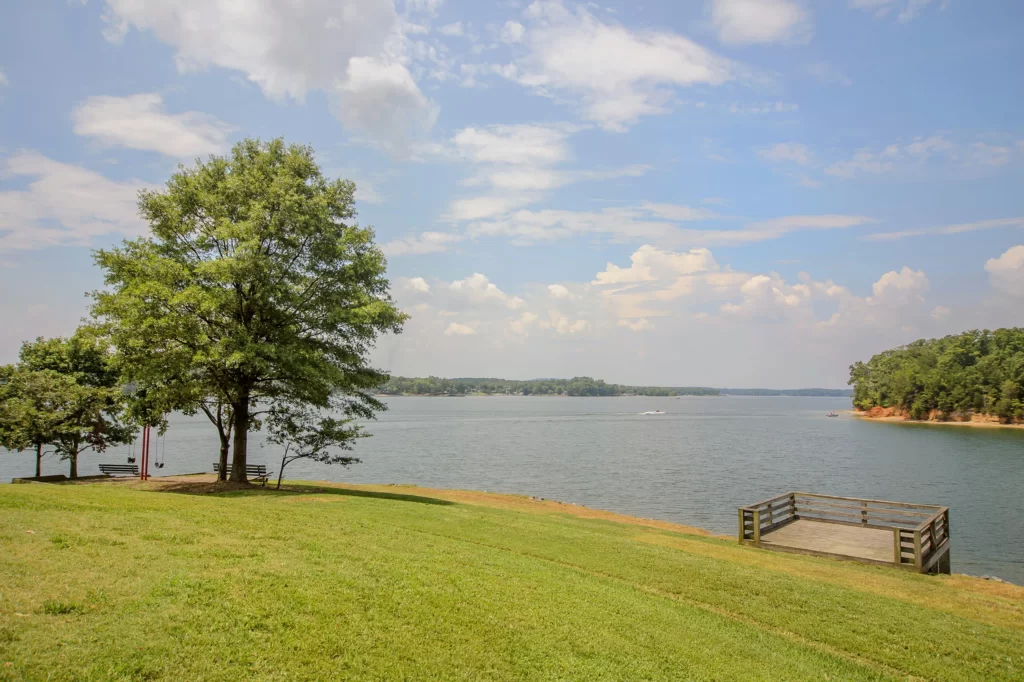HOA Management Services in Tega Cay, SC
William Douglas Management is a leader in customer service — the experience and expertise that your association needs and deserves!
Tega Cay, South Carolina, or the City of Tega Cay, is located in York County
Tega Cay is a planned community situated on a peninsula on the shores of Lake Wylie that was only established fifty-plus years ago. Tega Cay was incorporated in 1982 and was originally a joint venture between the Ervin Company and Crescent Land and Timber in 1970. The Ervin Company took the developer role and Crescent Land and Timber, a subsidiary of Duke Power (now Duke Energy), took a more passive role.
Some believe the name “Tega Cay” originates from the Catawba Indians that originally inhabited the area. While there is no evidence to support a Catawba Indian origin, the exact origin of the name is not exactly clear either. The name “Tega Cay” began appearing in print media in mid-1970, after the Ervin Company purchased the peninsula. In newspaper print ads marketing Tega Cay in 1970, they state the name “Tega Cay” is a translation of Tahitian for “beautiful peninsula.” This proves to be inaccurate, because “Tega Cay” does not translate into anything in Tahitian. Additionally, the Tahitian word for beautiful is “nehenehe.” One theory is that “Tega Cay” were words invented by the marketing people at the Ervin Company when they began selling lots.
Tega Cay was sold as a resort and golf course community with a Polynesian theme. The size of the original development was 1,540 acres. Before development began, an acre was valued at $357 and after development began, half-acre waterfront lots were selling for $18,000. At that time, the Ervin Company was one of the largest builders in the southeast and they built model homes with Polynesian themes. Tega Cay was one of the first Homeowner Associations (HOA) in the region with restrictive covenants. The initial developer went bankrupt and succeeding developers completed Tega Cay over the years. The last 550 acres were purchased by Newland Corporation in 1999 for the development of Lakeshore. The City of Tega Cay annexed beyond the original 1,540 acres peninsula, with the annexation of a commercial area by Highway 160.
Tega Cay, South Carolina, or the City of Tega Cay, is located in York County. Tega Cay is a suburb of Charlotte and is around 20 miles from downtown Charlotte. Per the U.S. Census, Tega Cay’s 2019 estimated population was 11,335. Tega Cay’s motto is “The Good Life.” The zip code for Tega Cay is 29708. The area codes are 803 and 839.
Tega Cay was incorporated as a city in 1982. A celebration of the founding is held every year on the 4th of July.
Tega Cay, South Carolina Historical population
Census Pop. %±
19903,016
2000 4,044 34.1%
2010 7,620 88.4%
2019 (est.) 11,335 48.8%
A Brief History of the Tega Cay Area
While Tega Cay is a relatively new city incorporated in 1982 and was originally organized as a planned community, there is a rich history to the area and the origins of Tega Cay. The Catawba River was dammed in 1904 with the construction of the Catawba Dam and Power Plant near India Hook, South Carolina. The creation of the dam originally formed Lake Catawba, which was renamed Lake Wylie in 1960. The peninsula, where present-day Tega Cay is located, was formed as a result of the creation of the lake. Before it was known as Tega Cay, historically the peninsula was known as India Hook Hills.
Thousands of years before there was a Lake Wylie, the Catawba River basin was home to the Catawba Indians. The Catawbas are also known as the Iswä. Iswä means “people of the river,” in the Catawba language. The written historical record before the 17th century about the Catawbas is limited, however, the Catawbas are the first recorded inhabitants of York County.
In 1540, Spanish explorer Hernando de Soto became the first European to record his contact with the Catawba. The next Catawba contact was with Spanish explorer Juan Pardo in 1567. This was recorded in Vandera’s narratives of Pardo’s expedition. German explorer John Lederer on his 1670 expedition came into contact with the Catawba and he recorded the tribe’s name as the Ushery. Early explorers estimated the Catawba’s population in the many thousands and up to as many as 25,000.

It is believed that the Catawba’s have lived in the Piedmont Regions of South Carolina, North Carolina, and up into Virginia for over 5,000 years. The University of North Carolina at Chapel Hill’s Archaeology Department has established the “Catawba Project.” The Catawba Project is the excavation and evaluation of seven Catawba Indian villages located in York and Lancaster Counties: Nassaw, Weyapee and Charraw Towns (c. 1750-1759), Old Town (c. 1763-1790), the Nisbet Site (c. 1763-1780), Ayers Town (c. 1781-1800), New Town (c.1790-1820), and the Bowers site (c.1800-1820). The archaeological excavations of these relatively recent Catawba villages have provided a great deal of insight into the lives of the Catawba Indians during the 18th and 19th centuries.
Tragically, contact with the settlers brought with it European diseases that the Catawbas had never encountered. These diseases, primarily smallpox, devastated the Catawba’s population. The European contact, generally starting around 1680, in under a hundred years reduced the Catawba’s population to around 400 by 1775. Per the 2010 U.S. Census, the Catawba Indian population has only increased by a little more than two thousand people since 1775 to 2,600.
An agrarian-based society, the Catawbas also fished and hunted to supplement their diet. While they hunted deer for food, they also hunted deer for their skins for trade with European traders. The early Catawbas lived in villages surrounded by walls constructed of logs and branches to help ward off warring Indian tribes. Within the village, there was an open area used for gatherings and a council house. Dwellings inside the village were small with rounded tops constructed of tree branches and bark. These dwellings were home to the extended family. Sweat lodges were an important part of Catawba society and within the walled village. These lodges could be constructed of logs but were typically constructed of circular stone. Typically, the only stone construction within a Catawba village.
Commerce between the Catawbas and the European traders had profound impacts on their society. Beginning in the 17th century the Catawbas traded deerskins and other animal furs, while the Europeans/colonials traded firearms, knives, cloth, alcohol, and trinkets. The trading between the Catawbas and the Europeans/colonials became so abundant and beneficial to all parties, the Catawbas became renowned for their business acumen. For a limited period, until the epidemics took their toll, the Catawbas flourished to a greater extent than most other tribes because of their trade. The Catawba Indian’s trading for firearms was a huge advantage against rival tribes. The good trading relationship that the Catawbas had helped ensured peace with the European settlers during their migration during the 18th century to the Piedmont of South Carolina and North Carolina. The Catawba protected the European settlers from other tribes with hostile intentions.
The Catawbas supported the Patriot side during the American Revolution. And it was during this period of the American Revolution (1765 – 1783) that smallpox epidemics affected the entire colonial and the Native American populations. Sadly, the Native American population was affected disproportionally more severely than the colonial population of European descent. So severely that by 1775, the number of Catawba Indians was reduced in population to around 400. The extreme population decline forced the surviving members to their reservation in York County or to temporarily join other Native American tribes that had been less affected by the epidemics.
European settlers began to arrive en masse to York County, or what would eventually become York County, in the 1750s. These settlers were predominately Scots-Irish. Most of these early settlers were arriving via the Great Wagon Road from Pennsylvania. While there were roads from the South Carolina coast inland, immigration from the coast was not a major factor as compared to the port in Philadelphia and the Great Wagon Road. This was due to Philadelphia having more shipping volume as compared to Charleston and the other ports.
Agriculture or farmer was the primary economic activity for the majority of the inhabitants of York County for the 18th and 19th centuries. Many of the farmers in the 18th and 19th centuries were subsistence farmers, meaning they consumed what they grew. As cotton cultivation became more prevalent in the area in the 1830s and 1840s it became a cash crop for farmers. Cash crops being crops grown specifically to sell to others. Cotton was the leading crop grown in York County from this time period and into the 20th century. The only exception being during the Civil War when cotton could not be exported because of the Union blockade of the southern ports, and corn was grown instead.
York County’s economic reliance on agriculture slowly receded in the late 19th century with textile manufacturing being introduced into the region. As York County entered the 20th century, textile manufacturing became a leading economic driver for the area. Textile manufacturing and textile-related jobs began to decline in the 1970s when imported textiles began to dominate domestic textile manufacturing. This decline was hastened by the North American Free Trade Agreement (NAFTA). NAFTA was the trade agreement between the United States, Canada, and Mexico that was ratified in 1993.

The reduction in agriculture and the waning of textile manufacturing in the area, have been overcome with the diverse industrial base that has slowly emerged over the past thirty years. The state of South Carolina has done an excellent job in attracting industry to the area. Another large factor in this economic rebound is the area’s proximity to Charlotte. Charlotte is the economic driver for the region and Tega Cay, along with other York County cities, have become bedroom communities for Charlotte. Tega Cay being twenty miles from downtown Charlotte makes it ideal for commuters. Tega Cay being just across the state line from North Carolina offers many advantages to these commuters. Cited as two popular reasons for working in Charlotte and living in Tega Cay are the lower taxes and excellent school system.
Need Association Management?
Contact Us
How to Start
The Process of Working With Us


REQUEST A PROPOSAL
Request a proposal online or call us directly.


WE WILL REVIEW YOUR CASE
Our team of highly trained professionals will review your case.


RECEIVE A CUSTOM TAILORED PLAN
We will create a customized management plan for your community.


SEAMLESS TRANSITION
We will implement a seamless management transition and integrate our tech.


SIT BACK & RELAX
Enjoy better, affordable and a more reliable, hassle-free management system.




